Filipino cuisine/ja: Difference between revisions
Created page with "===インドの影響=== {{anchor|Indian}} {{further/ja|History of Indian cuisine/ja}} thumb|[[curry powder/ja|カレー粉を使用した、現地の''ギナタン・マノック''の変種であるフィリピン風チキンカレー。]] インドの影響は、''ビビンカ''(インドネシアの''ビンカ''に類似)..." |
No edit summary |
||
| (13 intermediate revisions by the same user not shown) | |||
| Line 117: | Line 117: | ||
''Tokwa't baboy''は、[[tofu/ja|豆腐]]を揚げて、茹でた豚肉をガーリック風味の[[soy sauce/ja|醤油]]または酢に浸したもの。これは''[[pancit/ja|パンシット・ラグログ]]''や''[[pancit/ja|パンシット・パラボク]]''の付け合わせとしても提供される。 | ''Tokwa't baboy''は、[[tofu/ja|豆腐]]を揚げて、茹でた豚肉をガーリック風味の[[soy sauce/ja|醤油]]または酢に浸したもの。これは''[[pancit/ja|パンシット・ラグログ]]''や''[[pancit/ja|パンシット・パラボク]]''の付け合わせとしても提供される。 | ||
また、[[fish balls/ja|フィッシュボール]]、キキアム、イカボールなどのスナックである''tuhog-tuhog''には、甘いソースまたは辛いソースが添えられる。 | |||
===祝宴料理=== | ===祝宴料理=== | ||
| Line 441: | Line 439: | ||
インドの影響は、''[[bibingka/ja|ビビンカ]]''(インドネシアの''[[Bibingka/ja#Bibingka in Indonesia|ビンカ]]''に類似)、''[[Puto (food)/ja|プート]]''、''[[puto bumbong/ja|プートブンボン]]''などの米をベースにした菓子にも見られる。後者2つは、[[South Indian cuisine/ja|南インドの]]''[[puttu/ja|プットゥ]]''に由来する可能性が高く、このプットゥは[[:en:Maritime Southeast Asia|海洋東南アジア]]全体でバリエーションがある(例:''[[kue putu/ja|クエ・プトゥ]]''、''[[putu mangkok/ja|プトゥ・マンコック]]'')。一方、ルソン島でより人気のある''[[kare-kare/ja|カレカレ]]''は、[[:en:Seven Years' War|七年戦争]]中に[[:en:British occupation of Manila|イギリス軍がマニラを占領した]](1762年から1764年)際に、[[:en:sepoy|セポイ]]兵を含む部隊がフィリピンで[[curry/ja|カレー]]を作るためのスパイス不足からインド料理を即興で作ったことに起源をたどることができると言われている。これは、その名前と、カレーの一種を暗示する、濃厚で黄色からオレンジ色の[[annatto/ja|アナトー]]とピーナッツをベースにしたソースの説明になるとされている。 | インドの影響は、''[[bibingka/ja|ビビンカ]]''(インドネシアの''[[Bibingka/ja#Bibingka in Indonesia|ビンカ]]''に類似)、''[[Puto (food)/ja|プート]]''、''[[puto bumbong/ja|プートブンボン]]''などの米をベースにした菓子にも見られる。後者2つは、[[South Indian cuisine/ja|南インドの]]''[[puttu/ja|プットゥ]]''に由来する可能性が高く、このプットゥは[[:en:Maritime Southeast Asia|海洋東南アジア]]全体でバリエーションがある(例:''[[kue putu/ja|クエ・プトゥ]]''、''[[putu mangkok/ja|プトゥ・マンコック]]'')。一方、ルソン島でより人気のある''[[kare-kare/ja|カレカレ]]''は、[[:en:Seven Years' War|七年戦争]]中に[[:en:British occupation of Manila|イギリス軍がマニラを占領した]](1762年から1764年)際に、[[:en:sepoy|セポイ]]兵を含む部隊がフィリピンで[[curry/ja|カレー]]を作るためのスパイス不足からインド料理を即興で作ったことに起源をたどることができると言われている。これは、その名前と、カレーの一種を暗示する、濃厚で黄色からオレンジ色の[[annatto/ja|アナトー]]とピーナッツをベースにしたソースの説明になるとされている。 | ||
[[Atchara/ja|アチャラ]]は、[[Indian cuisine/ja|インドの]]''[[South Asian pickle/ja|アチャール]]''に由来し、[[:en:Indonesia|インドネシア]]、[[:en:Malaysia|マレーシア]]、[[:en:Brunei|ブルネイ]]の[[acar/ja|アチャル]]を介して伝播した。 | |||
[[Atchara]] | |||
===日本の影響=== | |||
=== | [[File:Snoice Halo Halo with Ube Ice Cream.jpg|thumb|left|カリフォルニア州[[:en:San Diego County|サンディエゴ郡]]で作られたハローハロー|200x200px]] | ||
[[File:Snoice Halo Halo with Ube Ice Cream.jpg|thumb|left| | 一部の著者は、[[halo-halo/ja|ハローハロー]]を、[[:en:Quiapo, Manila|キアポ]]の[[:en:Quinta Market|キンタ市場]]における1920年代または1930年代の[[:en:Japanese in the Philippines|日本人移民]]に特に関連付けている。これは、キアポの主要な氷供給源であった[[:en:Insular Ice Plant|島水プラント]]に近いことによる。 | ||
ハローハローの初期のバージョンの一つは、地元で[[:en:Japanese language|日本語]]の''mongo-ya''として知られるデザートであった。これは[[mung bean/ja|緑豆]]([[:en:Tagalog language|タガログ語]]:''monggo''または''munggo''、日本の赤[[Adzuki bean/ja|アズキ豆]]の代わりに使用)を茹でてシロップで煮たもの(''minatamis na monggo'')を、砕いた氷と牛乳、砂糖の上に載せて提供したものであった。時が経つにつれて、より多くの地元産の材料が追加され、現代のハローハローの創造と発展につながった。ハローハローとその日本の祖先との違いの一つは、材料の配置が主に氷の上ではなく氷の下にあることである。オリジナルの''monggo con hielo''タイプは、今日でも[[sweet corn/ja|スイートコーン]](''[[maiz con hielo/ja|マイス・コン・イエロ]]'')や''[[Saba banana/ja|サバ]]''[[banana/ja|バナナ]](''[[saba con hielo/ja|サバ・コン・イエロ]]'')を使用した同様のバリエーションとともに見られる。 | |||
[[File:Odong with sardines guisado (Philippines) 02.jpg|thumb|イワシ入りオドン]] | |||
[[File:Odong with sardines guisado (Philippines) 02.jpg|thumb| | |||
[[:en:Visayans|ビサヤ諸島]]の[[noodle soup/ja|麺料理]]''[[odong/ja|オドン]]''の名前は、[[:en:Japanese people|日本語]]の[[Udon/ja#Philippines|うどん]]に由来するが、うどん麺を使用せず、うどん料理と似ている点もない。これは、20世紀初頭に多数の日本人移民コミュニティが存在した[[:en:Mindanao|ミンダナオ島]]の[[:en:Davao Region|ダバオ地方]]と[[:en:Visayas Islands|ビサヤ諸島]]に起源を持つ。{{lang|ceb|odong}}麺は以前は[[:en:Okinawans|沖縄人]]によって地元で製造されていたが、現代の(明らかに黄色い){{lang|ceb|odong}}麺は[[:en:China|中国]]から輸入されている。 | |||
===アラブの影響=== | |||
{{ anchor | Arabic }} | {{ anchor | Arabic }} | ||
{{further | Arabic cuisine | Maritime history of India }} | {{further/ja | Arabic cuisine/ja | en:Maritime history of India }} | ||
フィリピン料理に対するアラブの影響は比較的小さい。歴史的に、アラブの影響はインドを経由してインドネシアとフィリピンに伝わった。初期にはアラブ人はインド人と貿易し、インド人はその後東南アジアと貿易した。後期には、海上航行の進歩により、アラブ人もフィリピンと直接貿易を開始した。 | |||
===インドネシアの影響=== | |||
== | [[File:Kropek0705.jpg|thumb|right|[[:en:Nagcarlan|ナグカルラン]]のクロペク]] | ||
[[File:Kropek0705.jpg|thumb|right| | フィリピンのいくつかの食品は、インドネシアの一部地域に由来する食品と密接な関係がある。例えば、[[krupuk/ja|クルプック]]に由来する''kropek''である。さらに、フィリピン南部には、ミンダナオのイスラム教徒マラナオ族によって作られる[[rendang/ja|ルンダン]]や、[[:en:Java|ジャワ島]]に起源を持つ[[satay/ja|サテ]]と密接な関係を持つ[[:en:Zamboanga peninsula|サンボアンガ]]の特産品''satti''がある。 | ||
< | <span id="Outside_the_Philippines"></span> | ||
== Outside the Philippines == | == フィリピン国外{{Anchor|Outside the Philippines}} == | ||
===アメリカ合衆国=== | |||
== | {{Main/ja|Filipino-American cuisine/ja}} | ||
{{Main|Filipino-American cuisine}} | フィリピン系アメリカ料理は、20世紀初頭に[[:en:History of Filipino Americans|フィリピン移民]]によって初めてアメリカ合衆国に持ち込まれ、現地の食材の入手可能性とアメリカ人の味覚の両方に適応した独自の料理の伝統が作り上げられた。 | ||
ロサンゼルスやニューヨーク市のような人口密度の高い都市に主に集中している、全米各地の「[[:en:Little Manila|リトルマニラ]]」としても知られる様々なフィリピン人コミュニティでは、フィリピン人経営のレストランやケータリングサービスが多く見られる。これらのコミュニティにある多くの家族経営やシェフ経営のレストランは、[[Inihaw/ja|イニハウ・ナ・リエンポ]]、[[Lumpiang Shanghai/ja|ルンピアン・シャンハイ]]、[[Philippine adobo/ja|アドボ]]、[[kare-kare/ja|カレカレ]]など、フィリピンの多くの代表的な料理をアメリカに紹介した。 | |||
ワシントンD.C.のBad Saint、ニューヨークのMaharlika、ロサンゼルスのLasaといったレストランは、伝統的な料理をさらにアメリカ人の味覚に合わせて食材、調理法、盛り付けにバリエーションを加え、大きな人気と称賛を得ている。1995年にエイミー・ベサとロミー・ドロタンがニューヨークにオープンしたセンドリヨンは、ウサギやウズラを使ったアドボ、ショウガやレモングラス風味の[[crème brûlée/ja|クレームブリュレ]]など、革新的で斬新な料理でフィリピン料理を普及させた最初の画期的なフィリピン系アメリカ料理レストランの一つと見なされている。2022年には、[[:en:Chicago|シカゴ]]のレストラン[[:en:Kasama (restaurant)|カサマ]]が、世界初の[[:en:Michelin star|ミシュランの星]]を獲得したフィリピン料理レストランとなった。 | |||
[[:en:James Beard Foundation Award|ジェームズ・ビアード賞]]受賞者であり、Bad Saintの創設者であるフィリピン系アメリカ人シェフの[[:en:Tom Cunanan|トム・クナナン]]は、さらにアメリカ料理とフィリピン料理を融合させたレストランPogiboyも開店した。ここでは、シニガン風味の[[fried chicken/ja|フライドチキン]]や、[[Vigan longganisa/ja|ビガン・ロンガニサ]]と[[tocino/ja|トシノ]]を詰めた[[hamburger/ja|ハンバーガー]]などの料理を提供している。サンフランシスコ地域にある別のレストラン、Señor Sisigは、伝統的なフィリピンの食材と風味をメキシコ料理のブリトーやナチョスと組み合わせることで、フィリピン料理とメキシコ料理の革新的な組み合わせを実店舗とフードトラックで提供している。Señor Sisigの共同創設者の一人であるエヴァン・キデラは、フィリピン料理をより身近な料理と融合させることで、アメリカ人の味覚によりよく合うようにフィリピン料理をアメリカに紹介したいと考えている。Barkada、Jeepney、Pogiboy、Maharlikaなどのこれらのフィリピン系アメリカ料理レストランの一部は、アメリカの食事客に''kamayan''の宴も紹介している。これは、様々なフィリピン料理を手で食べる伝統的な共同スタイルである。 | |||
[[ | |||
[[:en:Jollibee|ジョリビー]]などの人気フィリピン料理レストランチェーンもアメリカに進出しており、急速にファンを増やし、ソーシャルメディアでの存在感を高めている。フライドチキンやハンバーガーなどのアメリカ風の食品で有名なフィリピンのファストフードチェーン、ジョリビーは現在、国内に64店舗を展開しており、今後5年間で150店舗をオープンする計画である。このチェーンは、[[Pancit/ja|パンシット・パラボック]]、ハローハロー、アメリカ風のピーチマンゴーパイなどのフィリピン料理も提供している。フィリピンと中国を融合させたファストフードチェーンである[[:en:Chowking|チャウキン]]や、フィリピンのデザートや焼き菓子を提供するベーカリーである[[:en:Red Ribbon Bakeshop|レッドリボン]]などの他のレストランチェーンも、アメリカ国内で少数の様々な店舗を開店している。 | |||
多くのフィリピン料理やデザートに伝統的に使われている紫色のヤム芋、[[Ube (yam)/ja|ウベ]]は、近年アメリカで料理の材料として人気が急上昇している。伝統的に[[ube halaya/ja|ウベハラヤ]]や[[halo-halo/ja|ハローハロー]]などのデザートに供されてきたが、ワッフル、コーヒーケーキ、カップケーキ、ドーナツなど、様々なアメリカのレストランや食品(通常はデザート)で提供されているのを見ることができる。ウベは、カリフォルニア州とハワイ州のアメリカの醸造所でビールのフレーバーとしても人気を博している。アメリカの食料品店チェーンである[[:en:Trader Joe's|トレーダー・ジョーズ]]も、ウベ風味のアイスクリーム、パンケーキミックス、ショートブレッドクッキーを販売している。 | |||
[[Ube (yam)| | |||
==関連項目== | ==関連項目== | ||
Latest revision as of 10:04, 1 July 2025

| This article is part of a series on the |
| Culture of the Philippines |
|---|
 |
| Society |
| Arts and literature |
| Other |
| Symbols |
|
Philippines portal |
‘’‘フィリピン料理’’’は、フィリピン諸島全体に存在する100を超える異なる民族言語集団の料理で構成されている。主流のフィリピン料理の多くは、イロカノ、パンガシナン、カパンパンガン、タガログ、ビコラノ、ビサヤン、チャバカノ、マラナオなど、諸島に暮らすさまざまな民族言語集団や部族の食文化に由来している。 これらの料理は、海洋東南アジアと共有されているオーストロネシア系を主体とする先住文化を基盤としながら、中国料理、スペイン料理、アメリカ料理といった影響を受けて、数世紀にわたり発展してきたものである。これらの影響は諸島の文化を豊かにし、また、現地の食材を用いて地域の嗜好に合うように適応されてきた。 料理は、塩漬けにした魚を揚げてご飯と一緒に食べるような非常に素朴な食事から、カレーやパエリア、’’コシード’‘などのイベリア起源の’‘フィエスタ’’用の料理まで多岐にわたる。 代表的な料理には、’’レチョン’’(豚の丸焼き)、’’ロンガニーサ’’(フィリピンのソーセージ)、’’タパ’’(塩漬け牛肉)、’’トルタ’’(オムレツ)、’’アドボ’’(酢と醤油ベースの煮込み)、’’カルデレータ’’(トマトソースとレバーペーストで煮込んだ肉料理)、’’メチャド’’(牛脂を詰めた牛肉のトマト醤油煮込み)、’’ポチェロ’’(牛肉とバナナのトマト煮)、’’アフリタダ’’(鶏肉または牛肉と野菜のトマト煮込み)、’’カレカレ’’(牛テールと野菜のピーナッツソース煮込み)、’’ピナクベット’’(カボチャ、ナス、豆、オクラ、ゴーヤ、トマトなどをバゴオン(えびペースト)で味付けした煮物)、’’シニガン’’(肉または魚介と野菜の酸味のあるスープ)、’’パンシット’’(麺料理)、’’ルンピア’’(生または揚げた春巻き)などがある。
歴史
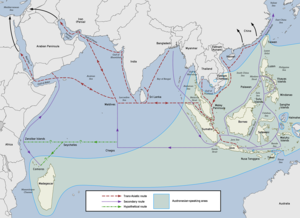
ネグリト人、フィリピン諸島の最初の民族は、採集された野生の塊茎、魚介類、狩猟肉からなる食事を摂る遊牧の狩猟採集民であった。
パラワンのイッレ洞窟からは、おそらくウベ(Dioscorea alata)と同定される塊茎の遺物が見つかっている(紀元前約11,000年)。これはまた、ウベが島嶼東南アジア原産であること、そして当時の人類がすでにデンプン質の植物を利用する方法を知っていた証拠でもある。ウベはまた、約3,500年前のバタン諸島の考古学的記録にも登場し、この地域の最も初期の農耕共同体と関連している。島嶼東南アジアとニューギニアで独自に栽培されたヤムイモ種の中で、ウベと小さなヤムイモだけが定期的に栽培され食用とされていた。他の種は、毒素ジオスコリンの含有量が高く、摂取前に正しく調理する必要があるため、通常は飢饉食と見なされていた。
フィリピンでフライドチキンが揚げられた最古の証拠は、フィリピンの考古学遺跡で発見された。
紀元前約6000年頃、その後の航海するオーストロネシア人(現代のフィリピン人の大多数がその子孫である)の移住により、養殖と農業の新しい技術、そして様々な家畜化された食料と動物が太平洋とインド洋を越えてもたらされた。
家畜化された豚は、約4500〜4000年前に台湾からルソン島北部にもたらされ、その後約3500年前に赤色スリップウェアとともにフィリピンからマリアナ諸島に広まった。
植民地時代以前
タロイモ栽培が、千年以上前にコルディリェーラの棚田建設のきっかけとなったと考えられている。タロイモは後に紀元1600年頃に米に取って代わられ、現在では米が主要な作物である。フィリピンで水稲が栽培されていた確固たる証拠は700年以前には不足しているものの、米栽培の開始はフィリピン料理における大きな発展であった。イフガオ族は基本的な道具のみを用いて、急峻な山腹に石と泥の壁で平らな面を作り、バナウェの棚田を建設し、高地での稲作を可能にした。中部および南西部のルソン島、ビコル半島、東部パナイ島の平野は米の主要生産地であり、余剰分は群島の他の地域に輸出されていた。米は富の象徴であり、多くの米を主原料とする珍味は重要な儀式で供物として使用された。アジアの多くの地域と同様に、米はフィリピン料理の主食である。米を主原料とする料理はすべての地域で一般的であり、様々な国の影響を受けている。例えば、アロスカルドは中国の粥に似ている。
植民地時代はフィリピンの文化と料理に大きな影響をもたらしたが、それ以前のフィリピン周辺国の影響、そしてフィリピン自国内の料理の起源もまた極めて重要である。スペインによる植民地化以前、フィリピンは中国と頻繁に交易を行っており、フィリピンの沿岸都市のいくつかには中国の拠点があった。中国人は島々に米麺(パンシットの主要な材料)と卵焼きをもたらした。フィリピン版はルンピアとして知られている。
スペイン植民地時代
スペインの支配は、マニラガレオン貿易ネットワークの形成から国内の農業改革に至るまで、群島の多くの料理にいくつかの大きな変化をもたらした。
ガレオン貿易は、2つの重要な料理的影響を島々にもたらした。中国とメキシコである。

ガレオン船の交易は主にマニラとアカプルコ、ヌエバ・エスパーニャ本土(現在のメキシコ)の間で行われたため、メキシコ料理の影響により、新世界とスペインの両方から多種多様な食材と調理法がもたらされた。アメリカ大陸からは主に作物、すなわちトウモロコシ、唐辛子、ピーマン、トマト、ジャガイモ、ピーナッツ、チョコレート、パイナップル、コーヒー豆、ヒカマ、様々なカボチャ、アナトー、アボカドなどが直接もたらされた。メキシコ人や他のラテンアメリカ人も、ソフリート、ソーセージ作り(ロンガニサはチョリソに似ているが)、パン焼きなど様々なスペインの調理法をもたらし、それによって地元に適応したエンパナーダ、パエリア、トルタと呼ばれるオムレツ、タマレスなどの多くの料理が生まれた。
同様に、移住したフィリピン人は、彼らの料理技術、料理、産物をアメリカ大陸やスペイン支配下にあったいくつかの太平洋諸島、特にグアムやマリアナ諸島にもたらした。フィリピン諸島産の米、サトウキビ、ココナッツ、柑橘類、マンゴー、タマリンドはすべてこれらの地域で帰化された。メキシコ料理では、フィリピンの影響はゲレロ州の西海岸で特に顕著であり、トゥバのワイン醸造、ギナタンと呼ばれるココナッツミルクベースの料理、そしておそらくセビーチェが含まれる。グアムでは、パンシットやルンピアのようなフィリピン料理が一般的な食事となり、ケラグエンやカラマイのような料理はフィリピンの先行料理(それぞれキラウィンとカラマイ)の現地適応版であった。
アメリカ植民地時代
米国は1898年の米西戦争で勝利を収め、パリ条約中にスペインから2000万ドルでフィリピンを購入した。フィリピンは1946年まで植民地のままであった。アメリカ人はフィリピン人にホットドッグ、ハンバーガー、アイスクリーム、アメリカ式フライドチキン(植民地以前から国内で知られていたフライドチキンとは異なる)を含むファストフードを導入した。また、スパム、コンビーフ、インスタントコーヒー、エバミルクなどの便利な食品も導入した。現在、スパムはしばしばガーリックライスと一緒に提供される一般的な朝食の品である。
現代
フィリピン料理は、新しい調理技術やスタイル、そして食材が国内に導入されるにつれて進化し続けている。シンプルで手の込んだ伝統料理、土着の料理、外国の影響を受けた料理が見られ、より現代的な人気のある国際料理やファストフードも同様である。しかし、フィリピン人の食事は、他のアジアの食事よりも総脂肪、飽和脂肪、およびコレステロールの含有量が高い。2013年、ノイノイ・アキノ大統領は、食品の品質と消費に関してフィリピン国民の食事と健康のための安全策を確立するため、共和国法第10611号、すなわち食品安全法に署名した。2022年、テイストアトラスはフィリピン料理を世界で23番目に良い料理と評価し、チキンイナサルとシシグは世界最高の料理の一つと評価された。
2025年、ミシュランガイドは、2026年までにグレーターマニラとセブ地域で初のレストランセレクションを発表すると発表した。これはフィリピンがこの権威ある国際的なレストランガイドに含まれる初めてのことである。
特徴

フィリピン料理は、甘味(tamis)、酸味(asim)、塩味(alat)の組み合わせを中心にしているが、ビコル地方、コルディリェーラ行政地域、イスラム系フィリピン人の間では、辛味(anghang)が料理の風味の基本となっている。
カウンターポイントはフィリピン料理の特徴であり、通常は甘いものと塩辛いものを対にして提供される。例としては、チャンポラード(甘いココア風味の米粥)がトゥヨ(塩漬けの天日干し魚)と、ディヌグアン(豚の血を使った風味豊かなシチュー)がプット(甘い蒸し米ケーキ)と組み合わせられる。また、未熟な果物、例えば緑色のマンゴー(わずかに甘いが非常に酸っぱい)は塩やバゴオンに浸して食べられる。さらに、チーズ(塩辛くて甘い)が甘いケーキ(ビビンカやプットなど)やアイスクリームのフレーバーとして使われる。
在来の材料


フィリピン料理には、様々な自生する食材が使われている。発展した生物相は特定の景観を生み出し、その土地の料理の風味を高める地元の食材をもたらした。柑橘類に属する果物であるカラマンシーは、これらのよく知られた食材の一つであり、主に料理に酸味を加えるために使われる。もう一つはタボンタボンで、植民地以前のフィリピン人が、特にキニラウ料理において抗菌成分として使用した熱帯の果物である。
この国では様々な種類のナッツも栽培されており、その一つがピリナッツである。フィリピンは食用種の唯一の輸出国として知られている。通常はメリエンダとして、または口の中で溶ける際のミルキーな食感により風味を高めるために他のデザートに組み込まれる。
酢は一般的な食材である。アドボは、そのシンプルさと調理の容易さだけでなく、数日間保存しても腐敗せず、1〜2日保存するとさらに風味が向上することでも人気がある。ティナパは燻製魚であり、トゥヨ、ダイン、ダンギットは塩漬けの天日干し魚で、冷蔵なしでも数週間腐敗しないため人気がある。
調理、提供、消費

フィリピンにおける調理と食事は、伝統的に家族の台所を中心とした非公式で共同の行事であった。食べ物は通常、コースではなく一度にすべて提供される。
フィリピンの食事文化は依然として伝統的な技術に依拠しているが、ジョリビーのような現代のファストフードレストランは、地元の味と外国の味を融合させている。ジョリビーが「チキンジョイ」や「ジョリースパゲッティ」のような食事を提供しているため、伝統的なフィリピンのレシピと大都市に適したファストフードを結びつけており、多くの人々にとって重要である。
西洋の影響をもたらしたスペイン占領期、フィリピン人はスプーンとフォークのペアの食器で食事をしていた。他の国のようにナイフが使われなかったのは、スペインがナイフの所持を禁じていたためである。フィリピン人はスプーンの側面を使って食べ物を「切る」。西洋の影響により、食事はしばしばフォーク、ナイフ、スプーンなどの食器を使って食べられるが、フィリピンの食卓で使われる主要な食器の組み合わせはナイフとフォークではなく、スプーンとフォークである。

Kamayanは「ブードルファイト」の概念でも使われる。これはフィリピン陸軍によって普及した食事様式で、食卓に広げたバナナの葉をメインの盛り付け皿とし、その上に米と様々なフィリピン料理が盛り付けられ、友好的、家族的、または共同でのごちそうに使われる。しかし、スプーンとフォークの使用は依然として一般的である。
一日の食事
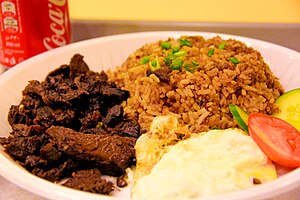
フィリピン人は伝統的に一日に3回の主食を摂る。すなわち、アルムサルまたはアガハン(朝食)、タンハリアン(昼食)、そしてハプナン(夕食)であり、さらに午前と午後の軽食はメリエンダ(minandálまたはminindálとも呼ばれる)と呼ばれる。
伝統的なフィリピンの朝食(アルムサル)には、パンデサル(小さなパン)、ケソン・プティ(新鮮で未熟な白いフィリピンチーズ、伝統的にカラバオの乳から作られる)、チャンポラード(チョコレート風味の米粥)、シログ(ガーリックライスのシナンガグまたはシナイングに目玉焼きと肉—例えばタパ、ロンガニサ、トシーノ、カルネ・ノルテ(コンビーフ)、または魚—例えばダイング・ナ・バングース(塩漬け干しのサバヒー)—やイットログ・ナ・プラ(塩漬けアヒル卵)が含まれる。コーヒーも一般的に提供され、特にバタンガス州の山々で生産される強い風味で知られるカペン・バラコが好まれる。

フィリピン語における特定の合成語は、フィリピンの朝食の人気のある組み合わせを表すために使われるようになった。そのような組み合わせの例としては、kankamtuyがある。これは、kanin(米)、kamatis(トマト)、tuyo(干し魚)の組み合わせである。もう一つはtapsiで、tapaとsinangágまたはsinaingの組み合わせである。その他の例としては、シログという接尾辞を使ったバリエーションがあり、通常はシナンガグまたはシナイング、そしてitlog(卵)と一緒に提供される何らかの肉を指す。最も一般的に見られる3つのシログは、タプシログ(肉の部分がタパ)、tocilog(肉の部分がトシーノ)、longsilog(肉の部分がロンガニサ)である。他のシログには、hotsilog(ホットドッグ付き)、bangsilog(バングース(サバヒー)付き)、dangsilog(ダンギット(アイゴ)付き)、spamsilog(スパム付き)、adosilog(アドボ付き)、chosilog(チョリソ付き)、chiksilog(鶏肉付き)、cornsilog(コンビーフ付き)、litsilog(マニラ・レチョン(またはルソン・レチョン)付き)がある。Pankaplogは、パンデサル、カペ(コーヒー)、itlog(卵)からなる朝食のスラングである。このような食事を専門とする店はタプシハンまたはタプシルーガンと呼ばれる。
典型的なフィリピンの昼食(タンハリアン)は、一品(または二品)の料理と米、時にはスープで構成される。焼かれたものであろうと、煮込まれたものであろうと、揚げられたものであろうと、米はすべての料理と一緒に食べられる。フィリピンの熱帯気候のため、食事にはキンキンに冷えた水、ジュース、または清涼飲料水が好まれる。
夕食は、主食ではあるものの、他国に比べて量が少ない。フィリピンの典型的な夕食は、通常、昼食の残りの食事である。フィリピンの夕食は通常、午後6時から8時の間に提供されるが、田舎ではもっと早く提供される。
メリエンダ

メリエンダはスペイン語に由来し、特に午後の軽い食事やおやつを意味し、アフタヌーンティーの概念に似ている。夕食に近い時間に摂る場合はメリエンダ・セナと呼ばれ、夕食の代わりになることもある。
フィリピン人は、フィリピン語でカフェ(コーヒー)を意味するkapéと一緒に摂る様々な選択肢を持っている。例えば、パンデサル、エンサイマダ(すりおろしたチーズと砂糖をまぶしたバター風味のブリオッシュ)、ホーピア(月餅に似た緑豆餡入りの菓子)、エンパナーダ(風味豊かな肉入りパスティ)などのパンやペストリーがある。また、kakanín、すなわちクッチィンタ、サピンサピン(多色で層になったペストリー)、パリタウ、ビコ、スーマン、ビビンカ、ピッチピッチィ(乾燥ココナッツを添える)などの餅米から作られた伝統的なペストリーも人気がある。

メリエンダ中にしばしば食べられる風味豊かな料理には、パンシット・カントン(炒め麺)、パラボク(エビベースのソースをかけた米麺)、トクワット・バボイ(茹でた豚の耳と揚げた豆腐をガーリック風味の醤油と酢のドレッシングで和えたもの)、そしてディヌグアン(豚の血を使ったスパイシーなシチュー)があり、これらはしばしばプット(蒸し米粉ケーキ)と一緒に提供される。
福建からの移民によって島々にもたらされた点心や餃子も、フィリピン風にアレンジされ、人気のメリエンダ料理となっている。イカ団子やフィッシュボールなどのストリートフードは、しばしば竹の串に刺され、醤油とカラマンシーの酸っぱい果汁を薬味として消費される。
プルタン

プルタンは(文字通り「拾い上げる」を意味するフィリピン語のpulotに由来し)、英語の「フィンガーフード」やスペイン語のタパスにほぼ対応する用語である。元々は酒やビールを伴う軽食であったが、フィリピン料理では前菜として、あるいはシシグのように主菜として取り入れられるようになった。
揚げ物のプルタンには、チチャロン(あまり一般的ではないがtsitsaronとも綴られる)、茹でてから二度揚げした豚の皮(二度目の揚げ物でパリパリ感と黄金色になる)、chicharong bituka(パリパリになるまで揚げた豚の腸)、chicharong bulaklak(chicharong bitukaに似ており、豚の腸の腸間膜から作られ、大まかに花に似た外観を持つためbulaklak(花)という名前が付いた)、そしてchicharong manok(カリカリになるまで揚げた鶏皮)がある。他の揚げ物のpulutanの例としては、クリスピーカニミソ、クリスピーカエルの脚、chicharong isdaまたは魚の皮のカリカリ揚げ、そしてpinaigiとしても知られるtugnasまたは豚の脂身の揚げ物がある。

焼き料理の例としては、isaw(鶏肉または豚の腸を串刺しにして焼いたもの)、inihaw na tenga(豚の耳を串刺しにして焼いたもの)、ポークバーベキュー(甘い醤油とニンニクのブレンドにマリネした豚肉を串刺しにして焼いたもの)がある。また、シシグは人気のプルタンで、豚の頬肉、耳、肝臓を最初に茹で、その後炭火で焼き、細かく刻んで刻んだ玉ねぎ、唐辛子、スパイスと一緒に調理する。

mani(ピーナッツ)などの小さな軽食は、フィリピンでは屋台の売り手によって、殻付きで蒸したり、塩味をつけたり、スパイスを効かせたり、ニンニク風味にしたりしてよく売られている。もう一つの軽食はクロペック、魚のクラッカーである。
Tokwa't baboyは、豆腐を揚げて、茹でた豚肉をガーリック風味の醤油または酢に浸したもの。これはパンシット・ラグログやパンシット・パラボクの付け合わせとしても提供される。
また、フィッシュボール、キキアム、イカボールなどのスナックであるtuhog-tuhogには、甘いソースまたは辛いソースが添えられる。
祝宴料理

お祝いの席では、人々が協力してより洗練された料理を準備する。食卓には、何時間もの準備を要する高価で手間のかかるごちそうが並べられることが多い。フィリピンのお祝いでは、レチョン(あまり一般的ではないがlitsonとも綴られる)が食卓の主役となる。通常は豚の丸焼きだが、子豚(lechonillo、またはlechon de leche)や子牛(lechong baka)も人気の成豚の代わりとして準備されることがある。伝統的には焼いた豚の肝臓から作られるレチョンソースと一緒に提供される。他の料理には、hamonado(蜂蜜漬けの牛肉、豚肉、または鶏肉)、relleno(鶏肉またはサバヒーの詰め物)、メチャード、アフリータダ、カルデレータ、プチェロ、パエリア、メヌード、morcon、エンブティード(他所で理解されるソーセージではなく、ミートローフ料理を指す)、スーマン(バナナなどの葉で蒸した風味豊かな米とココナッツミルクの混合物)、そしてパンシット・カントンがある。食卓には、レチェ・フラン、ウベ、サピンサピン、sorbetes(アイスクリーム)、totongまたはsinukmani(米、ココナッツミルク、緑豆のプディング)、ginataan(様々な根菜とタピオカパールが入ったココナッツミルクプディング)、そしてグラマン(寒天を原料とするゼリー状の食材またはデザート)などの様々なスイーツやペストリーも並べられる。
ノチェ・ブエナとして知られるクリスマスイブは、最も重要な祝宴である。この夜の食卓の主役は、クリスマスハムとエダムチーズ(queso de bola)である。スーパーマーケットはクリスマスシーズンにはこれらのごちそうで溢れかえり、赤ワイン、ブランデー、食料品、ペストリーに加えて、フィリピン企業からの人気のある贈り物となっている。主にクリスマスシーズンに教会前でビビンカと一緒に販売されるputo bumbongは、小さな竹筒で縦に蒸した紫色の餅米である。
日々の家庭での食事よりもお祝いの席でよく見られるルンピアン・サリワ、すなわち生春巻きは、柔らかいクレープで、kamote(サツマイモ)、singkamas(ヒカマ)、モヤシ、サヤインゲン、キャベツ、ニンジン、肉(多くは豚肉)の細切りなどが入った具材を包んだものである。温かくても冷たくても提供され、通常は甘いピーナッツとガーリックソースが添えられる。Ukoyは、すりおろしたパパイヤと小エビ(時にはモヤシも)を混ぜて揚げてエビのパティにしたものである。よくニンニク、塩、コショウで味付けした酢と一緒に食べられる。ルンピアン・サリワとUkoyは、フィリピンのパーティーでしばしば一緒に提供される。ルンピアン・サリワは、中国料理のポピアに由来する。
主食

ほとんどのアジア諸国と同様に、フィリピンの主食は米である。米はたいてい蒸して、肉、魚、野菜料理と一緒に常に提供される。残った米は、しばしばニンニクと一緒に炒めてシナンガグにされ、通常は目玉焼きや塩漬け肉またはソーセージと一緒に朝食に出される。米はしばしば主菜のソースやスープと一緒に食べられる。一部の地域では、米に塩、練乳、ココア、またはコーヒーを混ぜる。米粉は菓子、ケーキ、その他のペストリーを作るのに使われる。ココア入りの餅米、別名チャンポラードも、ダイング(干しニシン)と一緒に提供される一般的な料理である。
米とココナッツは、東南アジアの他の地域と同様に群島全体で主食であるため、これらの作物に基づいた類似または採用された料理や調理法が存在する。これらのいくつかは、特にビコルの有名なライングやsinilihan(ビコール・エクスプレスとして普及)におけるココナッツミルクの使用に見て取れる。シチューやスープの他の地域的なバリエーションで、一般的にギナタアンまたは「ココナッツミルク入り」とタグ付けされるものも、フィリピンの台所や飲食店に豊富に存在する。ビサヤ地方の料理で、理想的には竹筒でココナッツウォーターで煮込まれるビナコルは、通常鶏肉を主材料とする。

様々な果物や野菜が料理によく使われる。プランテン(フィリピンではサバとも呼ばれる)、カラマンシー、グアバ(bayabas)、マンゴー、パパイヤ、パイナップルは多くの料理に独特のトロピカルな風味を与えるが、空芯菜(kangkong)、白菜(petsay)、結球白菜(petsay wombok)、キャベツ(repolyo)などの主要な葉物野菜や、ナス(talong)、ササゲ(sitaw)などの他の野菜も同様によく使われる。ココナッツは遍在する。ココナッツの果肉はデザートによく使われ、ココナッツミルク(kakang gata)はソースに、ココナッツオイルは揚げ物に使われる。ジャガイモ、ニンジン、タロイモ(gabi)、キャッサバ(kamoteng kahoy)、紫芋(ube)、サツマイモ(kamote)などの根菜の豊富な収穫により、これらは容易に入手できる。トマト(kamatis)、ニンニク(bawang)、玉ねぎ(sibuyas)の組み合わせは多くの料理に見られる。

肉の主食には、鶏肉、豚肉、牛肉、魚がある。群島を囲む水域の結果として、シーフードは人気がある。人気のある漁獲物には、ティラピア、ナマズ(hito)、サバヒー(bangus)、ハタ(lapu-lapu)、エビ(hipon)、クルマエビ(sugpo)、サバ(galunggong、hasa-hasa)、カジキ(isdang-ispada)、カキ(talaba)、ムール貝(tahong)、アサリ(halaanとtulya)、大小のカニ(それぞれalimangoとalimasag)、ゲームフィッシュ、アブラソコムツ、マグロ、タラ(bakalaw)、アオカジキ、そしてイカ/コウイカ(両方ともpusitと呼ばれる)が含まれる。また、海藻(damong dagat)、アワビ、ウナギ(igat)も人気がある。

魚の最も一般的な食べ方は、塩をしてフライパンで焼くか、油で揚げるかして、米と野菜と一緒に簡単な食事として食べることである。また、pangatのようにトマトやタマリンドの酸っぱい汁で煮たり、野菜と酸味を加えるものでシニガンにしたり、酢と唐辛子で煮てpaksiwにしたり、熱い炭や薪で焼いたり(イニハウ)することもある。その他の調理法には、エスカベチェ(甘酸っぱい)、relleno(骨抜きにして詰め物をする)、またはキニラウ(セビチェに似ており、酢またはカラマンシーでマリネする)がある。魚は燻製にしたり(ティナパ)、天日干しにしたり(tuyoまたはdaing)して保存することもできる。
料理はしばばしば様々なディップソースと一緒に提供される。揚げ物は、しばしば玉ねぎ入りの酢、またはカラマンシー(フィリピンライムまたはcalamansi)を絞った汁入りの醤油に浸される。パティス(魚醤)は、ほとんどの魚介類用のディップソースとしてカラマンシーと混ぜられたり、ニラガと呼ばれるシチューに混ぜられたりする。魚醤、魚のペースト(バゴーン), エビペースト(bagoong alamang)、砕いたショウガの根(luya)は、調理中または提供時に料理によく加えられる調味料である。
メイン料理

アドボは、最も人気のあるフィリピン料理の一つであり、多くの人々によって非公式に国民料理と見なされている。通常、豚肉または鶏肉、時には両方を、酢、食用油、ニンニク、月桂樹の葉、コショウの実、醤油で作られたソースで煮込むか、蒸し煮にしたものである。液体を煮詰めて風味を凝縮させることで「ドライ」に調理することもできる。ビステック、または「フィリピン風ビーフステーキ」として知られる料理は、薄切りにした牛肉を醤油とカラマンシーに漬け込み、フライパンで焼いたもので、通常タマネギを添えて提供される。
よく知られた煮込み料理には、カレカレやディヌグアンがある。カレカレは「ピーナッツシチュー」としても知られ、牛テールやハチノスを主材料とし、ピーナッツベースの調理法で野菜とともに煮込む。通常、バゴーン(発酵させたシュリンプペースト)を添えて提供される。ディヌグアンは、豚の血、内臓、肉を酢で煮込み、トウガラシ、通常はシリンマハバで味付けしたものである。


パクシウとは、使用する肉の種類によって大きく異なる、酢をベースにした様々な煮込み料理を指す。Paksiw na isdaは魚を使用し、通常ショウガ、魚醤、場合によってはsiling mahabaや野菜が加えられる。Paksiw na baboyは豚肉、通常は豚足を使ったパクシウで、砂糖、バナナの花、水が加えられ、肉が甘いソースで煮込まれることが多い。フンバと呼ばれる同様のビサヤ料理には、発酵黒豆が加えられる。これらの料理はどちらも中華料理起源のpata timと関連がある可能性が高い。Paksiw na lechonはレチョン肉から作られ、すりつぶしたレバーやレバーペーストが加えられる。これにより風味が加わり、ソースがとろみを増し、料理が完成する頃には肉の周りでキャラメル状になる。パクシウ料理の中には、アドボと同じ基本的な材料を使用するものもあるが、他の材料が加えられ、材料と水の割合が異なるなど、調理法が異なっている。
‘’クリスピー・パタ’‘では、豚肉のすね(’‘パタ’’として知られる)をニンニク風味の酢に漬け込み、カリッときつね色になるまで揚げる。同様の調理法で豚脚の他の部位も調理される。 ‘’レチョン・マノック’‘は、ロティサリーチキンに対するフィリピン流のアレンジである。Andok’s、Baliwag、Toto’s Sr. Pedro’s、G.S. Pagtakhan’sなど、多くの屋台やレストランチェーンで提供されており、特別に味付けされた鶏肉を炭火でローストし、通常はマッシュした豚レバー、でんぷん、砂糖、スパイスで作られた「’‘サルサ’’」または’‘レチョンソース’’を添えて提供される。





『メカド』、『カルデレータ』、そして『アフリターダ』は、スペインの影響を受けたトマトソースベースの料理であり、互いによく似ている。これらの料理では、肉をトマトソース、ニンニクのみじん切り、玉ねぎで調理する。『メカド』という名前は、牛肉の塊に豚の脂を差し込み、それが牛肉の「ろうそく」から出る芯(mitsa)のように見えることに由来する。脂を詰めた肉は味付けしたトマトソースで調理され、後で薄切りにして調理したソースと共に供される。『カルデレータ』は牛肉でも作られるが、ヤギ肉と関連付けられることもある。肉の塊をトマトソース、ニンニクのみじん切り、玉ねぎのぶつ切り、エンドウ豆、ニンジン、ピーマン、ジャガイモで煮込み、シチューにする。レシピによっては、醤油、魚醤、酢、唐辛子、レバーのすりおろし、またはそれらの組み合わせを加えることもある。『アフリターダ』は、鶏肉や豚肉が使われる場合にこの料理に与えられる名前となる。リサール地方が発祥とされるもう一つの似た料理に『ワックナトイ』がある。豚肉または牛サーロインをジャガイモとカットソーセージと組み合わせ、ピクルスで甘くしたトマトベースのソースで調理する。『プチェロ』はスペインの『コシード』に由来する。牛肉とバナナまたはプランテンのスライスをトマトソースで煮込んだ甘いシチューである。
フィリピン人は『トシーノ』や『ロンガニーサ』も食する。『トシーノ』は鶏肉または豚肉で作られる甘く味付けされた保存肉であり、数日間マリネして熟成させてから揚げられる。『ロンガニーサ』は、通常豚肉で作られるが他の肉も使用されることがあり、甘いまたはスパイシーなソーセージである。伝統的にはアナトーの種子、または人工着色料によって赤く着色されることが多い。
フィリピンのスープは、肉や野菜、麺類が大きくごろごろと入っており、非常にボリュームがあり、シチューのようである。通常、軽い前菜としてではなく、お腹を満たすことを目的としている。それ自体が食事ではない場合、他の食事と一緒に提供され、ご飯と一緒に食べられる傾向がある。地元のメニューでは、『サバウ』(出汁)の項目でしばしば言及される。『シニガン』はこのカテゴリーで人気の料理であり、その酸味が特徴で、国民食の候補として『アードボ』と競い合うことも多い。通常、豚肉、牛肉、鶏肉、魚介類のいずれかで作られ、タマリンドやその他の適切な酸味のある材料で酸味を加える。例えば、魚介類の一部は、グアバの実や味噌を使って酸味を加えることができる。もう一つの料理は『ティノラ』である。これは、大きな鶏肉の塊と緑色のパパイヤ/サイヨーテのスライスを、唐辛子、ほうれん草、モリンガの葉と一緒に、生姜風味の出汁で煮込んだものである。『ニラガン・バカ』は、キャベツなどの野菜が入ったビーフシチューである。『ビナコル』は、ココナッツウォーターで調理され、ココナッツの果肉の細切りが添えられた温かいチキンスープである。『ラ・パス・バッチョイ』は、豚の内臓、砕いた豚の皮の揚げ物、刻んだ野菜を添え、生卵をのせた麺料理である。同じ名前の別の料理にはミスア、牛の心臓、腎臓、腸が使われるが、卵や野菜は含まれない。『マミ』は、鶏肉、牛肉、豚肉、ワンタン、または内臓(『ラマン・ルーブ』と呼ばれる)で作られた麺料理である。マ・モン・ルクはこれで有名であった。もう一つの鶏肉の麺料理は『ソータンホン』で、春雨(『ソータンホン』とも呼ばれ、料理の名前の由来となっている)、鶏肉、そして時にはキノコで構成されている。

麺料理は一般的に『パンシット』と呼ばれる。『パンシット』のレシピは主に麺、野菜、肉またはエビの薄切りで構成されており、使用される麺の種類によってバリエーションが区別されることが多い。『マミ』やラ・パス風の『バッチョイ』のような一部の『パンシット』は麺スープであるが、「ドライ」な種類は調理法において『チャウメン』に匹敵する。また、スパゲッティ、または現地語で『イスパゲッティ』と呼ばれるものは、スパゲッティ・ボロネーゼを改良したバージョンである。トマトソースの代わりにバナナケチャップで作られることもあり、砂糖で甘くされ、ホットドッグのスライスがトッピングされる。
フィリピンではいくつかの種類の米粥が人気である。一つは『アロス・カルド』で、鶏肉、生姜、時にはサフランと共に炊いた米粥で、ネギ(チャイブ)、揚げニンニク、ココナッツミルクで飾られ、一種の薄粥となる。もう一つのバリアントは、牛のトライプで作られた『アロス・カルド』である『ゴト』である。また、『チャンポラード』と呼ばれる全く異なる米粥もあり、これは甘く、チョコレート風味で、しばしば朝食時に『トゥヨ』や『ダイン』と一緒に供される。
もう一つの米料理は『アロス・ア・ラ・バレンシアーナ』で、スペインの地域バレンシアにちなんで名付けられたスペインのパエリアが地元料理に取り入れられたものである。『ブリンゲ』はパエリアと類似点があるが、もち米、ココナッツミルク、ターメリックを使用した地元の米料理である。『キアムポン』は豚肉の細切れ、チャイブ、ピーナッツをトッピングした炒飯の一種である。ビノンドやマニラの中華料理店で見られる。『カマロン・レボサド・コン・ハモン』は、マニラ市内のチャイナタウンであるビノンド地区の伝統的な料理として記述されている。
菜食主義者向けには、『ディネンデン』がある。これはモリンガの葉(『マルンガイ』)とニガウリのスライスで構成される料理である。また、『ピナクベット』もあり、これは『バゴーン』で風味付けされた野菜の煮込みである。『キニラウ』として知られるシーフードサラダの一種は、魚やエビなどの生のシーフードを地元の酢に浸すだけで調理され、ココナッツミルク、玉ねぎ、香辛料、その他の地元の食材が加えられることもある。これはペルーのセビーチェに匹敵する。
付け合わせ

Itlog na pula (赤い卵) は、アヒルの卵を塩水または粘土と塩の混合物で数週間熟成させて塩辛くしたものである。これらは後に固ゆでされ、店頭で販売される前に鶏卵と区別するために赤い食用色素で染色される(そのためこの名前が付いた)。これらはしばしば角切りにしたトマトと混ぜて供される。アチャラ は、ザワークラウトに似たパパイヤのピクルスの付け合わせである。それはしばしばタパやダイングのような揚げ物の付け合わせとして添えられる。
ナタ・デ・ココ は、ココナッツウォーターの発酵によって作られる、弾力のある半透明のゼリー状の食品であり、パンデサルと一緒に供されることがある。Kesong puti は、カラバオの乳から作られる柔らかい白チーズである(ただし、ほとんどの市販品では牛乳も使用されている)。すりおろした完熟ココナッツ (niyog) は、通常、甘い米ベースのデザートと一緒に供される。
パンとペイストリー

典型的なフィリピンのベーカリーでは、パンデサル、モナイ、エンサイマダがよく売られている。パンデサルはスペイン語のpan de sal(文字通りには「塩パン」)に由来し、コーヒーと一緒に(そして時には浸して)食べられるのが一般的な朝食である。通常はロールパンの形をしており、パン粉をまぶして焼かれることが多い。その名前が示唆するのとは異なり、パンデサルは焼く際に塩をほとんど使用しないため、特に塩辛くはない。モナイは、よりしっかりとした、わずかに密度の高い重いパンである。エンサイマダは、スペインのエンサイマーダに由来し、バターを使って作られ、しばしば砂糖とすりおろしたチーズがトッピングされるペイストリーで、特にクリスマスによく食べられる。ウベ(紅山芋)やマカプノ(ココナッツの一種で、その果肉はしばしば細かく切られ、甘くされ、保存され、デザートとして提供される)などのフィリングが使われることもある。フィリピンのベーカリーでよく売られているものには、糖蜜と混ぜた細かく砕いたココナッツを詰めた甘いパンであるパン・デ・ココもある。プトゥック(一部の地域では「スターブレッド」または「ピナゴン」としても知られている)は、文字通り「爆発する」という意味で、火口のような表面に砂糖をかけた小さくて硬いパンロールを指す。カババヤン(フィリピンのマフィン)は、しっとりとした質感を持つ小さな、甘いゴング型のマフィンである。スパニッシュブレッド(スペインのスパニッシュブレッドであるパン・デ・オルノとは関係ない)は、クロワッサンが三日月形になる前の形に似た巻きペイストリーで、砂糖とバターからなるフィリングが詰められている。

また、様々なフィリングで風味付けされたシフォンケーキのロールであるピアノノのようなロールもある。ブラソ・デ・メルセデスは、カスタードフィリングを巻き込んだメレンゲのシートから作られるロールケーキまたはゼリーロールである。前のデザートと似ているが、巻かれずに層状の見た目を持ち、通常はキャラメル化された砂糖とナッツを特徴とするサン・リバルがある。シルバニャスは、大きくて楕円形のクッキーサイズのデザートで、バタークリームフィリングの両側に薄いメレンゲがあり、砕いたクッキーがまぶされている。過度に甘くなく、豊かで、サクサクしており、歯ごたえがあり、同時にバターの風味がする。バルキージョは、甘くて薄いサクサクしたウエハースを筒状に巻いたもので、中身が空洞で売られていることもあれば、ポルボロン(甘く焼いた小麦粉と砕いたナッツを混ぜたもの)が詰められていることもある。メレンゲもまた、スペインの影響によりフィリピンに存在するが、それらはメレンゲと呼ばれ、すべての母音が発音される。レチェ・フランは、フランスのクレームブリュレに似た、卵と牛乳で作られたカスタードプリンの一種である。レチェ・フラン(元のスペイン語のflan de leche、文字通り「ミルクフラン」の現地での呼称)は、コンデンスミルクとより多くの卵黄で作られたスペインのフランの濃厚なバージョンである。レチェ・フランは通常、直火またはコンロで蒸されるが、稀に焼かれることもある。レチェ・フランは祝宴の定番である。
レチェ・フランの濃厚なバージョンであるトシノ・デル・シエロも似ているが、卵黄と砂糖がはるかに多い。

非常に濃厚なエッグカスタードフィリングのエッグパイは、地元のベーカリーの定番である。通常、露出したカスタードの上面が褐色になるように焼かれる。ブコパイは、若いココナッツの果肉と乳製品から作られたフィリングで作られる。トゥロネス・デ・カスーイのようなミニペイストリーは、カシューマジパンをキャンディの包み紙に似せて作られたウエハースで包んだもので、25セント硬貨ほどの大きさのミニチュアパイのような見た目である。ナポレオーネス(これもまた、すべての母音が発音される)もあり、甘い牛乳ベースのフィリングが詰められたミルフィーユペイストリーである。
カリカリとした甘い二度焼きパンであるビスコチョのような硬いペイストリーもある。別の焼き菓子はシニピットで、カリカリとした砂糖のグレーズで覆われた甘いペイストリーで、一本のロープのように見える。シニピットに似たスナックは、口語的にシンガリンと呼ばれ、道端で食べられる。中が空洞でカリカリしており、塩味がある。

より柔らかいお菓子には、砂糖がまぶされたシフォンケーキの一種であるマモンがあり、その名前はスペイン語で胸を意味する俗語に由来する。また、クレマ・デ・フルータもあり、これはクリーム、カスタード、砂糖漬けの果物、ゼラチンが順に層になってトッピングされた手の込んだスポンジケーキである。スポンジケーキに似たものにマモンシージョがあり、これは一般的に大きなマモンケーキから切り取られたスライスを指すが、同名の果物とは関係がない。イニピットのようなサンドイッチペイストリーは、カスタードのフィリングを挟んだ薄いシフォンの二層から作られ、バターと砂糖がトッピングされている。別のマモンのバリエーションとして、マモン・トスターダがあり、これは基本的にマモンシージョをカリカリになるまでトーストしたものである。

西洋と東洋の影響の両方を反映した詰め物入りペイストリーが一般的である。風味豊かな甘い肉のフィリングが詰められたエンパナーダ、ターンオーバー型ペイストリーが見られる。通常、ひき肉とレーズンが詰められており、油で揚げたり焼いたりすることができる。シャオパオは、中国のパオズの現地版である。ブチもまた、中国起源と思われるスナックである。一口サイズのブチは、揚げた生地のボール(しばしば米粉から作られる)に甘い緑豆ペーストが詰められ、外側はゴマで覆われている。一部のバリエーションでは、フィリングとしてウベも使われる。また、月餅に似たホピアには多くの種類があり、形(平らな円形の詰め物入りからキューブまで)や食感(主に練りパイ生地を使用するが、月餅のものに似たものもある)、フィリングが異なる。
調理方法


フィリピン語で一般的に使われる調理方法や用語を以下に示す:
- アドボ (inadobo) − 酢、油、ニンニク、醤油で調理される。
- アフリターダ – トマトソースで煮込まれる。
- Babad (binabad, ibinabad) − マリネすること。
- Banli (binanlian, pabanli) − 湯通しすること。
- バゴーン (binagoongan, sa bagoong) − 発酵魚介ペースト(バゴーン)で発酵させるか、または調理すること。
- ビビンカ – 伝統的にもち米で作られる焼き菓子。
- Binalot – 文字通り「包まれたもの」。これは一般的にバナナの葉、パンダンの葉、あるいはアルミホイルで包まれた料理を指す。包みは一般的に食べられない(ルンピアとは対照的である)。
- Buro (binuro) − 発酵させたもの、ピクルス、または塩や酢で保存したもの。他のフィリピン語で発酵米を指す場合、タパイと同義である。
- Daing (dinaing、padaing) − 塩漬けにして乾燥させたもので、通常は魚または魚介類。他のフィリピン語ではtuyô、buladまたはbuwadと同義である。
- Giniling – 挽肉。特にアロス・ア・ラ・クバーナでは、ピカディージョの同義語として使われることがある。
- ギナタアン (sa gata) − ココナッツミルクで調理される。
- Guisa (guisado, ginuisa) − ニンニクと玉ねぎでソテーされる。gisa、gisado、ginisaとも表記される。
- ハモナド (endulsado) – 甘いパイナップルソースでマリネされるか、または調理される。pininyahanまたはminatamisと同義であることがある。
- Halabos (hinalabos) – 主に貝類に用いられる。自身の汁と炭酸飲料で蒸される。
- ハローハロー - 砕いた氷、エバミルクまたはコンデンスミルク、そしてウベ、甘く煮た豆、ココナッツの細切り、サゴ(パール)、グラマン(ゼリー)、ピニピグ米、茹でたタロ芋または柔らかいヤム芋の角切り、果物のスライス、フランなど様々な材料から作られ、ウベアイスクリームが1スクープ添えられる。
- Hilaw (sariwa) – 未熟な(果物や野菜)、生の(肉)。一般的に未調理の食品(lumpiang sariwaのように)にも使われる。
- Hinurno – オーブン(pugon)で焼かれるか、またはローストされる。
- Ihaw (inihaw) − 炭火で焼かれる。ビサヤ地方ではsinugbaとも呼ばれる。inasalは肉を串に刺して焼くことを指す。
- キニラウ または キラウィン − 酢やカラマンシーの汁、ニンニク、玉ねぎ、ショウガ、キュウリ、ピーマンでマリネされた魚介類。また、生で食べる、または新鮮なものを食べるという意味もあり、Hilawの同根語である。
- Lechon (nilechon) − 串焼きにされる。litsonとも表記される。
- Lumpia – 食べられる皮で包まれた風味豊かな食べ物。
- Minatamis (minatamisan) − 甘くしたもの。ハモナドに似ている。
- Nilaga (laga, palaga) − 茹でられる/煮込まれる。
- Nilasing − ワインやビールなどのアルコール飲料で調理される。
- Paksiw (pinaksiw) − 酢で調理される。
- パンシット (pansit, fideo) – 主にフィリピン系中国料理に由来する麺料理。
- Pangat (pinangat) − 塩水/塩漬け水にトマトや熟したマンゴーなどの果物と一緒に茹でられる。
- Palaman (pinalaman, pinalamanan) − siopaoのように「詰められた」もの。ただし「palaman」はサンドイッチの具も指す。
- ピナクベット (pakbet) − 通常、sitaw(ササゲ)、カボチャ、talong(ナス)、ampalaya(ニガウリ)などとバゴーンで野菜を調理すること。
- Pinakuluan – 茹でられた。
- Pininyahan – パイナップルでマリネされるか、または調理される。hamonadoと同義であることがある。
- Prito (pinirito) − 揚げられるか、または油で揚げられる。スペイン語のfritoに由来する。
- プート – 伝統的にもち米で作られる蒸しケーキ。
- Relleno (relyeno) – 詰め物をされた。
- Sarza (sarciado) – 濃いソースで調理される。
- Sinangag – ガーリックチャーハン。
- Sisig - ビールのお供として特に人気のフィリピンの伝統的な料理。豚の様々な部位で作られる。
- シガン (sinigang) − 酸味のあるスープで煮込まれたもので、通常はタマリンドをベースとする。他の一般的な酸味料には、グアバ、生のマンゴー、カラマンシーとしても知られるカラモンディンなどがある。
- タパ または ティナパ – 乾燥させて燻製にしたもの。タパはこのように処理された肉を指し、ほとんどはマリネしてから乾燥させて揚げたものである。一方Tinapaは、ほとんどの場合、燻製魚を指す。
- タパイ – 酵母で発酵させたもので、通常は米で、伝統的にはタパヤンの壺で発酵させる。初期段階ではburoと同義である。また、ライスワインを含む様々な発酵米製品を指すこともある。非常に短時間発酵させたもち米のバージョンはガラポンとして知られており、フィリピンのカカニン(米菓子)に不可欠な材料である。tinapay(発酵させたパン)の同根語である。
- Tosta (tinosta, tostado) – トーストされた。
- トルタ (tinorta, patorta) – フィリピン北部では、オムレツのように卵で調理すること。フィリピン南部では、小さなケーキの一般的な用語。
飲料
冷たい飲み物とシェイク


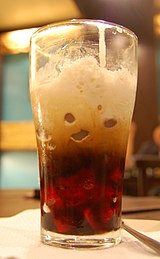
熱帯気候のため、冷たい飲み物は人気がある。冷たいフルーツドリンクやフルーツシェイクを売る屋台は多くの都市部で一般的であり、中には緑のミカン(dalandanまたはdalanghita)、ザボン(suha)、パイナップル(pinya)、バナナ(saging)、サワーソップ(guyabano)をベースにしたものもある。シェイクには通常、砕いた氷、エバミルクまたはコンデンスミルク、そしてマンゴー、アボカド、マスクメロン、ドリアン、パパイヤ、イチゴ、スイカなどの果物が含まれる。
その他の冷たい飲み物には、先スペイン時代のマレー起源(マレー語: gula melaka)のフレーバー付きアイスドリンクで、サゴと寒天ゼラチンにバナナエキスを加えてシロップとして添えることがあるsago't gulaman、若ココナッツにストローを刺して直接飲む新鮮なbukoまたはココナッツジュース(ボトル入りのココナッツジュース、削ったココナッツの果肉、砂糖、水から作られる新鮮さに劣るバリエーションもある)、そしてカラマンシーまたはフィリピンライムのジュースで、通常ハチミツ、シロップ、または砂糖で甘くしたカラマンシージュースがある。
淹れる飲料
フィリピンは主にコーヒーを飲む国である。バタンガスの山々で生産される最も人気のあるコーヒーの一つは、カペ・バラコとして知られている。もう一つの有名なコーヒーのバリエーションは、シベットコーヒーである。これはコルディレラ地方ではkape motit、タガログ地方ではkape alamid、ミンダナオではkape musangと呼ばれる。有機栽培で知られるカリンガコーヒーも急速に人気を集めている。ハイランドコーヒー、またはベンゲットコーヒーは、ロブスタ種とエクセルサ種のブレンドである。
フィリピンにコーヒーハウスが設立される前から、コーヒーはフィリピン人の食事の一部であった。カリンデリアでは食事と一緒に提供されることが多かった。1997年のスターバックス開店は、他のコーヒーショップへの道を開いた。
フィリピンにおけるお茶の消費は、主に中高所得層の健康意識の高まりによって促進されている。お茶は一般的にフィリピン野生茶または茶の木を用いて淹れられる。様々な添加物を使ったいくつかの既知のお茶のバリエーションがある。パンダンアイスティーもその一つで、パンダンの葉とレモングラス(現地ではtangladとして知られる)で作られる。サラバットは、時にジンジャーティーとも呼ばれ、ショウガの根から淹れられ、通常は寒い時期や、インフルエンザや喉の痛みなどの病気にかかったときに提供される。
2010年代後半には主要都市でティーハウスが開店し、通常の冷たいデザイナーコーヒーよりも手頃な価格のミルクティーが普及したことで、お茶はよく知られた食のトレンドになった。フィリピンの有名なティーハウスチェーンにはチャタイムとセレニティーがある。
Tsokolateはフィリピン式のホットチョコレートである。伝統的に乾燥、焙煎、粉砕され、錠剤状に成形された純粋なカカオ豆であるtableaで作られる。クリスマスシーズン、特に子供たちの間で人気がある。
アルコール飲料
フィリピンには、地元の醸造所や蒸留所によって製造された多種多様なアルコール飲料がある。レッドホースビールは最も人気のあるビールの一つである。
- 伝統的な飲み物


トゥバ(タディ)は、ヤシの若い茎を切り取って抽出した新鮮な樹液から作られる一種の強い酒である。ヤシの茎の切断は、通常早朝にmanangueteと呼ばれる、ヤシの木に登ってその日のうちに顧客にトゥバを供給するために抽出する人によって行われる。午前中にたまったヤシの樹液または滴り落ちる液は正午までに収穫され、買い手に届けられ消費のために準備される。時にはこれが1日に2回行われ、トゥバの収穫が正午と夕方の2回行われることもある。通常、トゥバはmanangueteが持ってきた直後に消費される必要があり、そうしないと飲用に適さないほど酸っぱくなる。未消費のトゥバは、しばしば数日間発酵させてヤシ酢にするために壺に保存される。トゥバは蒸留されて、比較的高いアルコール度数で知られる中性酒であるランバノグ(アラック)を生産することができる。
ランバノグは、ココナッツワインまたはココナッツウォッカとして一般的に記述されるアルコール飲料である。この飲み物は、未開のココナッツの花の樹液を蒸留したもので、その効力と高いアルコール度数(80〜90プルーフ)で知られている。ほとんどのランバノグ蒸留所はルソン島ケソン州にある。ランバノグ生産の標準化に向けた絶え間ない努力により、品質が向上した。現在、ランバノグは他国に輸出されており、天然成分と効力により外国の顧客を魅了し続けている。
タプイは、発酵させたもち米から作られるフィリピンの伝統的なアルコール飲料である。贅沢なアルコール風味、適度な甘さ、そして長く残る後味を持つ透明なワインである。平均アルコール度数は14%または28プルーフで、防腐剤や砂糖は含まれていない。tapuyの認知度を高めるため、フィリピン米研究所は、有名なフィリピン人シェフやバーテンダーによるtapuyを材料の一つとするレシピやカクテルを掲載した料理本を作成した。
- 現代の飲み物
ビールまたはserbesa(スペイン語の"cerveza"に由来)は、フィリピンで最も広く入手可能なアルコール飲料である。サンミゲル・ペールピルゼンは最も人気があり、広く販売されているブランドである。サンミゲルライトやゴールドイーグルビールなどの関連サンミゲルビールブランドと共に、同社は市場シェアの92.7%を占めている。地元のコングロマリットであるアジア・ブルワリーが製造するビア・ナ・ビアは、広く販売されている別のペールピルスナータイプのビールである。アジア・ブルワリーはまた、コルト45、アサヒスーパードライ、ハイネケン、タイガービールなど、他の多くのマスマーケットビールをライセンス生産し、流通させている。その他のビールブランドには、レッドホースビール、ローンスタースーパーライト、ローンスタースーパーライトゼロ、カールスバーグ、クアーズライト、サンミゲルスーパードライ、サンミゲルストロングアイス、そして最近ではマニラビールがある。国際市場のトレンドを反映し、都市部のバーでは、地元産および輸入のクラフトビールを様々なスタイルで提供し始めている。
ヒネブラ・サンミゲル(GSMブルーやGSMプレミアムジンも含む)のような地元のものも、ギルビーのような輸入品も、いくつかのジンが一般的に見られる。ジンをボトルの形状で呼ぶ人もいる。円形のボトルはbilog、正方形または長方形のボトルはkwatro kantos(文字通り「四隅」を意味する)である。ジンは、バリエーションを考案するために他の材料と組み合わされることがある。
デザート



フィリピンは熱帯国であるため、多くのデザートが米とココナッツから作られている。よく見られるデザートの一つはビビンカで、バター、白チーズのスライス、itlog na maalat(塩漬けアヒル卵)、そして時にはすりおろしたココナッツをトッピングした温かいライスケーキである。また、砂糖、バター、ココナッツミルクで作られたビコと呼ばれるもち米の菓子もある。さらに、ピノイ・ドーナツとしても知られるbitsu-bitsuというデザートがあり、揚げた米粉にマスコバド糖シロップをかけたものである。また、もち米粉、ココナッツ、ココナッツミルクで作られ、揚げて串に刺し、黒糖のグレーズを塗ったkariokaもある。もう一つの茶色いライスケーキはクチンタである。
プートは、様々な大きさや色で調理される、もう一つの有名な甘い蒸しライスケーキの例である。サピンサピン(sapinは層を意味する)は、米粉、紫ヤム芋、ココナッツミルクで作られた3層の3色菓子で、そのゼラチン状の外観が特徴である。パリタウは、ごま、砂糖、ココナッツで覆われた米粉のパティであり、ピチピチはチーズまたはココナッツで覆われたキャッサバのパティである。Tibok-tibokはカラバオミルクをベースにしており、マハブランカに似ている。軽食としては、ビナトグはコーンの粒と細切りココナッツで作られる。包装された軽食はバナナの葉やヤシの葉で包んで蒸されることがある。スマンはもち米から作られ、蒸される。冷たいデザートとしては、かき氷、牛乳、砂糖、そしてココナッツ、ウベハラヤ(つぶした紫ヤム芋)またはウベアイスクリーム、leche flan、プランテン、パラミツ、小豆、タピオカ、ピニピグなどの追加の材料で作られるデザート、ハローハローがある。
かき氷を使った他の同様のお菓子には、牛乳と一緒にかき氷を供するsaba con yelo、熟したプランテンを刻んで黒糖でキャラメリゼしたミナタミス・ナ・セージング、蒸したコーンの粒、砂糖、牛乳と一緒にかき氷を供するmais con yelo、そして甘く刻んだココナッツの細切りにグラマン、牛乳、パンダンの葉の汁またはエキスを加えたbuko pandanがある。ソルベテス(アイスクリーム)も人気があり、一部の地元版では牛乳の代わりにココナッツミルクが使用されている。アイスキャンディーは、通常フルーツジュース、チョコレート、または緑豆やウベなどの地元の材料から作られる人気のある冷凍スナックである。生産者によって様々なフレーバーがあり、チョコレート味とbuko(ココナッツ)味が最も人気がある2つである。もう一つのデザートで、しばしばクリスマスや大晦日に提供されるのは、マンゴーフロートである。これはグラハムクラッカー、マンゴー、クリーム、牛乳を皿に重ねて冷蔵または急速冷却するデザートである。
地域料理
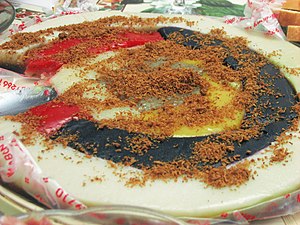

フィリピン諸島には様々な民族が居住しており、それが多様な郷土料理を生み出している。
ルソン島
山がちなイロコス地方出身のイロカノ族は、一般的に茹でた野菜や淡水魚を多く摂取し、苦味や塩味の強い料理を特に好む。多くの料理は、塩の代わりによく使われる発酵魚であるバゴオン・モナモンで味付けされる。イロカノ族は、ピナクベットのように茹でた野菜にbugguongをよく味付けする。郷土料理には、アリの柔らかい白い幼虫や、小さな生きエビの「ジャンピングサラダ」などがある。
イゴロット族は、ローストした肉、特にカラバオの肉、ヤギの肉、鹿肉を好む。
穏やかな亜熱帯気候のため、バギオは、周辺の山岳地帯とともに、その農産物で有名である。低温地域では枯れてしまうような温帯の果物や野菜(イチゴが顕著な例である)がそこで栽培されている。また、「鼻くそをほじる」という意味のsundot-kulangotと呼ばれるお菓子でも知られている。これは、製粉されたもち米粉と糖蜜を混ぜた粘り気のある甘い菓子で、pitogoの殻に入れられ、粘り気のある物質を「ほじる」ための棒が添えられている。
イサベラ州はカバガンのパンシット・カバガンで知られ、イラガン市のイナタタとビナライは市内で一年中作られるライスケーキであり、特に四旬節の間は両方とも有名な珍味である。カガヤン州はアルカラ町の有名なカラバオミルクキャンディで、トゥゲガラオ市はパンシット・バティル・パトゥンとブコロールで知られている。

パンガシナン州のカラシアオ町は、一種の蒸しライスケーキであるプートで知られている。
カパンパンガン料理は、地元の料理人が利用できる地域のあらゆる農産物を利用する。パンパンガ州で生産されるお菓子の中には、ロンガニサ(オリジナルの甘辛いソーセージ)、calderetang kambing(風味豊かなヤギのシチュー)、トシノ(甘く味付けした豚肉)などがある。豚の頬肉と内臓を組み合わせて、カパンパンガン族はシシグを作る。

タガログ族の料理は州によって異なる。ブラカン州はチチャロン(豚の皮)やputoのような蒸し米と芋のケーキで人気がある。ここはpanghimagas(デザート)の中心地であり、茶色のライスケーキやkutsinta、sapin-sapin、スマン、キャッサバケーキ、ube halaya、そしてサンミゲル、ブラカン州の菓子類の王様である有名なカラバオミルクキャンディーpastillas de leche(そのpabalat包装付き)が有名である。マニラ東部のリサール州カインタは、フィリピンのライスケーキやプディングで知られている。これらは通常、ココナッツミルクと黒糖を混ぜて乾燥した砕けるような食感になるまで煮詰めたlatikがトッピングされる。latikのより現代的で時間節約な代替品は、フライパンでトーストしたココナッツフレークである。フィリピンのシエラマドレ山脈の中腹に位置するアンティポロは、sumanとカシューナッツ製品で知られている町である。ラグナ州はbuko pie(ココナッツパイ)とpanutsa(ピーナッツブリトル)で知られている。バタンガス州にはタール湖があり、これはタール火山を取り囲む水域である。この湖には、タール湖の環境に適応した陸封された海洋種を含む75種の淡水魚が生息している。これらの種のうち8種は商業的価値が高い。これらには、地元でmaliputoとして知られるロウニンアジの個体群が含まれ、これはtalakitokとして知られる海洋のロウニンアジとは区別される。もう一つの商業的に重要な種は、この湖に固有の唯一知られている淡水イワシであるtawilisである。バタンガス州はまた、その特別なコーヒー、カペン・バラコでも知られている。ケソン州、特にルクバン町もその郷土料理で知られており、ルクバン・ロンガニサ、パンシット・ハブハブ、ハルディネラが最も有名である。ビコル地方に近いことから、ライング(ケソン州の一部地域ではtinutoと呼ばれる)やシナントールなどのココナッツミルク料理の影響も同州で感じられる。Sumanも同州の特筆すべき食品であり、特にインファンタ町やタヤバス市で有名である。アンティポロのものと同じ材料を持つが、インファンタとタヤバスのsumanを独特なものにしているのはその包装とサイズである。インファンタのsumanはサイズが小さく、通常1パックに20個ずつまとめられているのに対し、タヤバスのsumanも包装が独特で、火を灯したロウソクのように見える長い尾があり、これは市の守護聖人である労働者聖イシドロの祝日にsumanを投げるという伝統に関連している。
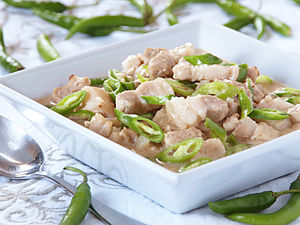
ビコル地方は、辛い、または唐辛子を使った料理への美食的な嗜好で知られている。おそらく最もよく知られているビコラノ料理は、非常に辛いビコル・エクスプレスである。この地域はまた、ナトン(laingまたはピナガットとしても知られる、タロイモの葉で豚肉または魚を煮込んだもの)の有名な産地でもある。
キヌノット・ナ・イスダン・ツナ(ビコル語で「クノット」は剥がす、細かく裂くの意)は、キハダマグロ、マルンガイ、シリン・ラプヨ、ココナッツミルクを組み合わせたビコラノ族の伝統的な料理である。
ビサヤ諸島
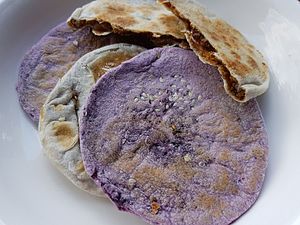
ビサヤ諸島では、batuan(Garcinia binucao)という形の別の酸味剤が料理に使われる。これは緑がかった黄色で、いくぶん丸く、直径4センチメートル以上の果物である。硬い外皮を持ち、非常に酸味のある果肉といくつかの種子を含んでいる。
トゥルトゥルは、ギマラス島でのみ作られる一種の岩塩で、付け合わせとして炊き込みご飯に振りかけられる。この塩は、葦、小枝、竹の小片が潮によって海岸に運ばれ、しばらく海水に浸された後、大量に燃やされ、毎日塩水が継続的にかけられることによって作られる。灰はその後、kaingsで継続的に濾され、鍋で調理される。
バコロドはネグロス・オクシデンタル州の州都である。バコロドには、観光客に人気の美味しい郷土料理を提供するレストランが豊富にある。「火で調理された」という意味のイナサルで知られている。「チキンイナサル」は、チキンバーベキューの地元版である。赤いアチウエテまたはアナトーの種で調理され、赤みがかった色になり、油を塗って火で焼かれる。この街はまた、ピアヤ、ナポレオーネ、pinasugbo(揚げてキャラメルをかけたバナナにごまを振りかけたもの)など、様々な名物料理でも有名である。
レイテ州は、ビナゴル、カラバオミルクパスティリャス、Suman Latik、モロンの産地である。タクロバン料理は、kinagod(おろしココナッツ)とhatok(ココナッツミルク)が広く使われることで独特である。この街ではhinatokan(ココナッツミルクを使った料理)をよく見かける。フンバはこの州が発祥と言われており、この地域の料理は国内の他の地域よりも明らかに甘みが強い。レイテ州は海に面しているため、州内には多くのシーフード料理がある。Masag(カニ)、tilang(ホタテ)、pasayan(エビ)は、この地域で一般的なシーフードである。ワライ族の味覚は多様で、各家族やangkan(氏族)が独自のレシピを作り出している。この州のその他の郷土料理には、ロスカス(ラード、アニス、小麦粉、砂糖、バター、卵で作られた硬いクッキー)とブカヨ(ココナッツの細切りキャンディ)がある。
アクラン州は、ubad(バナナの髄)で調理された鶏肉料理イヌバラン・マノク、およびココナッツウォーターとレモングラスで調理された鶏肉料理ビナコル・ナ・マノクと同義である。特に興味深いのは、タミロク(フナクイムシ)で、生で食べるか、酢やカラマンシーなどの酸っぱいソースに浸して食べる。アクランの料理では、鶏肉とココナッツミルク(gata)が特に多く使われる。

イロイロ州は、福建語の「ba-chui」(肉の切れ端を意味する)に由来するバッチョイ発祥の地である。本物のbatchoyには、mikiと呼ばれる生卵麺、数時間かけて煮込んだbuto-butoスープ、そして牛肉、豚肉、ブラーロを地元のギナモス(エビペースト)と混ぜたものが含まれる。トッピングには、揚げニンニク、砕いたチチャロン、ネギ、豚の腸とレバーのスライスがたっぷりと乗せられる。同州で見られるもう一つのパンシットの一種はパンシット・モロで、ワンタンスープを応用したもので、イロイロの有名な地区であるモロ町の特産品である。他のパンシットとは異なり、パンシット・モロは乾いておらず、スープ状であり、細長い麺ではなく米粉で作られたワンタンの皮を使用する。イロイロ州はまた、2種類のカディオスまたはキマメをベースにしたスープでも有名である。1つ目はKBLまたはカディオス・バボイ・カグ・ランカである。名前が示す通り、この料理の3つの主要な材料はkadyos、baboy(豚肉)、langka(ここでは未熟なパラミツが使われる)である。もう1つはKMUまたはカディオス・マノク・カグ・ウバドである。この料理は主にkadyos、manok(イロイロではBisaya nga manokと呼ばれる放し飼いの鶏が好ましい)、そしてubad(バナナの茎/幹の薄く切った白い芯)で構成されている。これらの料理の両方で、酸味剤として別のイロンゴの材料が利用されている。この材料はbatwanで、マンゴスチンに密接に関連する果物であり、西ビサヤ地方と隣接するネグロス島では非常に人気があるが、フィリピンの他の地域では一般的に知られていない。
ロハス市は、イロイロ市やカリボに加えて、西ビサヤ地方のもう一つの食の目的地である。イロイロ市からバスで2〜3時間のこの沿岸都市は、豊かな川、河口、海があるため、「フィリピンのシーフード首都」を自負している。ムール貝、カキ、ホタテ、エビ、海藻、アサリ、魚など、数多くのシーフード料理が市内のバイバイ地区で提供されている。
セブ島は、レチョンの変種で知られている。「セブ式」で調理されたレチョンは、パリパリした外皮と、様々なスパイスのブレンドによって与えられる独特の風味を持つしっとりジューシーな肉が特徴である。セブ島はまた、ドライマンゴーやキャラメルタルトなどの甘いものでも知られている。
ボホール島ではカラマイが人気である。パラワン島では、ワニ肉が茹でられ、塩漬けにされ、トシノになる。ロンブロン島では、バナナの葉で調理された、たたいて味付けされたエビの肉と米が特産料理である。
ミンダナオ島
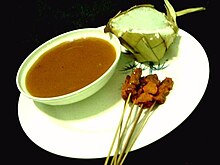

ミンダナオ島、パラワン島南部、スールー州、タウィタウィ州の料理は、東南アジアに共通するターメリック、コリアンダー、レモングラス、ガランガル、クミン、様々な種類の地元産ライムの皮や葉、シナモン、唐辛子といったスパイスで豊かに味付けされており、これらはフィリピンの他の地域ではあまり使われない食材である。キリスト教徒、イスラム教徒、またはルマド族であるミンダナオ島とスールー諸島の先住民族の料理は、マレーシアやブルネイの濃厚でスパイスペーストを中心としたマレー料理、インドネシア料理やタイ料理、その他の東南アジア料理と共通点が多い。ミンダナオ料理は、16世紀後半から17世紀初頭にかけてスペイン植民地化が始まる直前の、国内の他のほとんどの地域の先ヒスパニック期フィリピン料理の文化的成果を代表している。同様の料理や風味のヒントは、ビコル地方やコルディレラ地方にも見られ、これらの地域はミンダナオ島と同様にココナッツとスパイスペーストが豊富な味覚を好む。
よく知られているミンダナオ島とスールー州の料理には、サッティ(サテ)とginataang manok(スパイス入りココナッツミルクで煮込んだ鶏肉)がある。ミンダナオ島の一部地域はイスラム教徒が多数を占めており、豚肉はほとんど消費されず、ラム肉、羊肉、ヤギ肉、牛肉が主な赤身肉として選ばれる。
ルンダンは、スマトラ島のミナンカバウ族に起源を持つ、しばしば辛い牛肉のカレーである。ビリヤニ、クルマ、キヨニング(ピラフ)は、元々はインド亜大陸の料理であるが、ミンダナオ風にアレンジされ、特別な行事で供される。
ピヤンガン・マノクはタウソーグ族の料理で、スパイスに漬け込んでバーベキューにした鶏肉を、トーストしたココナッツの果肉を注入したココナッツミルクとともに供する。
Chupá culoとcuracha con gatâは、それぞれココナッツミルクで煮込んだ貝類と、ココナッツミルクとスパイスをブレンドしたソースで調理したカニで作られたサンボアンガ料理の例である。他にもエストファドン・バボイ、sicalañg、アルファホール、endulzao、タマル、パエリア、arroz a la Valenciana、rebosao、toronなど、よく知られたサンボアンガ料理がある。
キャッサバ芋、サツマイモ、ヤム芋などの人気のある作物が栽培されている。
サンバルは、ブラチャン、タマリンド、芳香性スパイス、唐辛子で作られた辛いソースで、この地域の多くの料理の人気のベースとなっている。
パラパは、マラナオ料理とマグインダナオ料理に独特で広く使われている人気の調味料であり、細かく刻んだ古いココナッツ、サクラブ(ネギの一種)、ショウガ、ガランガル、唐辛子、塩、コショウ、ターメリックをベースとしている。
この地域で人気のあるもう一つの料理はティユラ・イトゥムである。これは、ショウガ、ガランガル、唐辛子、ターメリック、トーストしたココナッツの果肉(これが濃い色を与える)で軽く味付けされた、牛肉または鶏肉の黒いスープである。
ラマウ(ブコサラダ)は、若いココナッツ、そのジュース、牛乳またはオレンジジュースと氷を混ぜたものである。
ストリートフードと軽食


ペストリーやデザート以外にも、食事の前菜や副菜としても機能する、よりボリュームのある「メリエンダ」(軽食)がある。Siomaiは中国の焼売の現地版である。 ルンピアは、生または揚げた春巻きである。生春巻き(lumpiang sariwa)は、準備に手間がかかるため、通常フィエスタや特別な機会のために作られる。一方、揚げ春巻き(lumpiang prito)の一種であるlumpiang shanghaiは、通常、豚ひき肉と野菜の組み合わせが詰められ、甘酸っぱいディップソースを添えて提供される。他のバリエーションでは、豚ひき肉とエビが詰められ、酢ベースのディップソースが添えられる。Lumpiaは冷凍食品として商品化されている。ビーフパレスは、マニラで一般的なストリートフードである。シャワルマなどの中東料理は、1980年代後半にフィリピンで人気を博した。
フィリピンには独特のストリートフードがある。これらの中には、ケバブのように串に刺されたものもある。その一例がbanana-cueで、丸ごとのバナナまたはプランテンを短い細い竹串に刺し、黒糖をまぶしてフライパンで焼いたものである。Kamote-cueは、皮をむいたサツマイモを串に刺し、黒糖で覆ってフライパンで焼いたものである。フィッシュボールやイカボール(カラマレスを含む)もフライパンで焼かれ、竹串に刺して客に渡される。客は甘いソースか塩味のソースに浸すかを選ぶことができる。これらは市場で冷凍で、また露天商によって売買されている。
ツロンは、プランテンのスライスと時々パラミツを詰めた卵巻きまたはフィロの皮からなる一種のルンピアで、揚げて砂糖がまぶされる。

タホは、柔らかい豆腐(タホ本体)、arnibalと呼ばれる黒いキャラメルシロップ、そしてタピオカパールから作られる温かいお菓子である。スポーツイベントのスタンドで「ホットドッグ」や「ピーナッツ」と叫ぶ売り子のように、「taho!」と叫びながら近隣を巡回する露天商によってよく売られている。時々、tahoは冷やして提供され、最近ではチョコレートやイチゴなどのフレーバーが追加されている。Tahoは、元々中国の軽食豆花に由来する。
他にiskrambol(英語の「to scramble」に由来)と呼ばれる、シャーベットに似た氷ベースのお菓子もある。かき氷に様々なフレーバーが加えられ、通常チョコレートシロップがトッピングされる。中身を「スクランブル」するか混ぜて、大きなストローで飲む。後にスキムミルク、チョコレートまたはストロベリーシロップ、そしてマシュマロ、チョコレートまたはキャンディスプリンクル、ライスクリスピー、タピオカパールなどのトッピングが追加され、「アイススクランブル」、または単に「スクランブル」と修正された。

卵を使ったストリートフードには、オレンジ色の衣に浸して天ぷらのように揚げたクウェクウェク(ゆでたウズラの卵を使用)がある。Toknenengは、鶏卵または鴨卵を使ったkwek-kwekの大型版である。もう一つのフィリピンの卵のスナックはバロットで、基本的に孵化前の家禽の卵、通常はアヒルまたは鶏の卵を茹でたものである。これらの受精卵は、胚が所定のサイズに達するまで発育させられてから茹でられる。通常、酢と塩と一緒に消費される。また、penoyと呼ばれる別の卵料理もあり、これは基本的に胚を含まない固ゆでの未受精鴨卵である。tahoと同様に、balutは露天商が商品を叫びながら宣伝して売られている。
Okoyまたはukoyと綴られるものは、フィリピンのもう一つの衣をまとった揚げストリートフードである。衣と一緒に、通常、もやし、細かく刻んだカボチャ、そして殻付きの非常に小さなエビが含まれる。一般的に酢とチリの組み合わせに浸して食べられる。
その他のストリートフードには、すでに述べたプルタンがある。例えば、イサウ(味付けした豚または鶏の腸を串に刺して焼いたもの)、betamax(焼いた鶏の血を小さく立方体に切って提供したもの。その粗雑な見た目がベータマックスのテープに似ていることから名付けられた)、アディダス(人気のある靴ブランドにちなんで名付けられた鶏の足のグリル)、そしてプロベン(鶏の腺胃にコーンスターチをまぶして揚げたもの)などである。サツマイモで作られたフライドポテトは「ピノイフライ」とも呼ばれている。ほとんどのストリートフードは、特定の学校や大学の近くで見られることが多く、例えばメトロマニラの大学街などがある。
また、バーガーマシン(「眠らないバーガー」の愛称で親しまれている)、エンジェルスバーガー、フランクス・N・バーガーズ、ミニッツバーガーなど、24時間営業のハンバーガー店が全国に存在する。
パグパグは、ゴミ捨て場や廃棄物処理場から漁られたレストラン(通常はファストフード店)の残り物の食品である。パグパグ食品は、スーパーマーケットが廃棄し、期限切れの食品が集められるゴミ収集車から漁られる、期限切れの冷凍肉、魚、または野菜であることもある。これはフィリピンの極度の貧困に苦しむ人々によって食べられる。パグパグの販売は、貧しい人々が住む地域で儲かるビジネスであった。パグパグは基本的に、ホームレスの人々が日中、フィリピンの様々なファストフードの地元レストランから集めた食べ物であることが多い。
珍味料理

フィリピンの食事における珍味料理には、醤油、塩、酢で調理される野原のコオロギであるcamaroがあり、パンパンガ州で人気である。papaitanは、ヤギや牛肉の内臓を胆汁で味付けしたシチューで、特徴的な苦味(pait)がある。スープ・ナンバー5(「スープ#5」とも綴られる)は、雄牛の睾丸から作られるスープで、マニラビノンドのオンピン街のレストランで見られる。そして、ピニクピカン・ナ・マノクは、鶏肉を柔らかくし、血を染み込ませるために、鶏を叩き殺す調理法である。その後、羽を取り除くために火で焼かれ、塩とイタグ(塩漬け/燻製豚肉)で煮込まれる。この料理の準備のために鶏を叩く行為は、1998年フィリピン動物福祉法に違反する。
外国の影響
スペインの影響
中国の影響
アメリカの影響

インドの影響

インドの影響は、ビビンカ(インドネシアのビンカに類似)、プート、プートブンボンなどの米をベースにした菓子にも見られる。後者2つは、南インドのプットゥに由来する可能性が高く、このプットゥは海洋東南アジア全体でバリエーションがある(例:クエ・プトゥ、プトゥ・マンコック)。一方、ルソン島でより人気のあるカレカレは、七年戦争中にイギリス軍がマニラを占領した(1762年から1764年)際に、セポイ兵を含む部隊がフィリピンでカレーを作るためのスパイス不足からインド料理を即興で作ったことに起源をたどることができると言われている。これは、その名前と、カレーの一種を暗示する、濃厚で黄色からオレンジ色のアナトーとピーナッツをベースにしたソースの説明になるとされている。
アチャラは、インドのアチャールに由来し、インドネシア、マレーシア、ブルネイのアチャルを介して伝播した。
日本の影響

一部の著者は、ハローハローを、キアポのキンタ市場における1920年代または1930年代の日本人移民に特に関連付けている。これは、キアポの主要な氷供給源であった島水プラントに近いことによる。
ハローハローの初期のバージョンの一つは、地元で日本語のmongo-yaとして知られるデザートであった。これは緑豆(タガログ語:monggoまたはmunggo、日本の赤アズキ豆の代わりに使用)を茹でてシロップで煮たもの(minatamis na monggo)を、砕いた氷と牛乳、砂糖の上に載せて提供したものであった。時が経つにつれて、より多くの地元産の材料が追加され、現代のハローハローの創造と発展につながった。ハローハローとその日本の祖先との違いの一つは、材料の配置が主に氷の上ではなく氷の下にあることである。オリジナルのmonggo con hieloタイプは、今日でもスイートコーン(マイス・コン・イエロ)やサババナナ(サバ・コン・イエロ)を使用した同様のバリエーションとともに見られる。

ビサヤ諸島の麺料理オドンの名前は、日本語のうどんに由来するが、うどん麺を使用せず、うどん料理と似ている点もない。これは、20世紀初頭に多数の日本人移民コミュニティが存在したミンダナオ島のダバオ地方とビサヤ諸島に起源を持つ。odong麺は以前は沖縄人によって地元で製造されていたが、現代の(明らかに黄色い)odong麺は中国から輸入されている。
アラブの影響
フィリピン料理に対するアラブの影響は比較的小さい。歴史的に、アラブの影響はインドを経由してインドネシアとフィリピンに伝わった。初期にはアラブ人はインド人と貿易し、インド人はその後東南アジアと貿易した。後期には、海上航行の進歩により、アラブ人もフィリピンと直接貿易を開始した。
インドネシアの影響

フィリピンのいくつかの食品は、インドネシアの一部地域に由来する食品と密接な関係がある。例えば、クルプックに由来するkropekである。さらに、フィリピン南部には、ミンダナオのイスラム教徒マラナオ族によって作られるルンダンや、ジャワ島に起源を持つサテと密接な関係を持つサンボアンガの特産品sattiがある。
フィリピン国外
アメリカ合衆国
フィリピン系アメリカ料理は、20世紀初頭にフィリピン移民によって初めてアメリカ合衆国に持ち込まれ、現地の食材の入手可能性とアメリカ人の味覚の両方に適応した独自の料理の伝統が作り上げられた。
ロサンゼルスやニューヨーク市のような人口密度の高い都市に主に集中している、全米各地の「リトルマニラ」としても知られる様々なフィリピン人コミュニティでは、フィリピン人経営のレストランやケータリングサービスが多く見られる。これらのコミュニティにある多くの家族経営やシェフ経営のレストランは、イニハウ・ナ・リエンポ、ルンピアン・シャンハイ、アドボ、カレカレなど、フィリピンの多くの代表的な料理をアメリカに紹介した。
ワシントンD.C.のBad Saint、ニューヨークのMaharlika、ロサンゼルスのLasaといったレストランは、伝統的な料理をさらにアメリカ人の味覚に合わせて食材、調理法、盛り付けにバリエーションを加え、大きな人気と称賛を得ている。1995年にエイミー・ベサとロミー・ドロタンがニューヨークにオープンしたセンドリヨンは、ウサギやウズラを使ったアドボ、ショウガやレモングラス風味のクレームブリュレなど、革新的で斬新な料理でフィリピン料理を普及させた最初の画期的なフィリピン系アメリカ料理レストランの一つと見なされている。2022年には、シカゴのレストランカサマが、世界初のミシュランの星を獲得したフィリピン料理レストランとなった。
ジェームズ・ビアード賞受賞者であり、Bad Saintの創設者であるフィリピン系アメリカ人シェフのトム・クナナンは、さらにアメリカ料理とフィリピン料理を融合させたレストランPogiboyも開店した。ここでは、シニガン風味のフライドチキンや、ビガン・ロンガニサとトシノを詰めたハンバーガーなどの料理を提供している。サンフランシスコ地域にある別のレストラン、Señor Sisigは、伝統的なフィリピンの食材と風味をメキシコ料理のブリトーやナチョスと組み合わせることで、フィリピン料理とメキシコ料理の革新的な組み合わせを実店舗とフードトラックで提供している。Señor Sisigの共同創設者の一人であるエヴァン・キデラは、フィリピン料理をより身近な料理と融合させることで、アメリカ人の味覚によりよく合うようにフィリピン料理をアメリカに紹介したいと考えている。Barkada、Jeepney、Pogiboy、Maharlikaなどのこれらのフィリピン系アメリカ料理レストランの一部は、アメリカの食事客にkamayanの宴も紹介している。これは、様々なフィリピン料理を手で食べる伝統的な共同スタイルである。
ジョリビーなどの人気フィリピン料理レストランチェーンもアメリカに進出しており、急速にファンを増やし、ソーシャルメディアでの存在感を高めている。フライドチキンやハンバーガーなどのアメリカ風の食品で有名なフィリピンのファストフードチェーン、ジョリビーは現在、国内に64店舗を展開しており、今後5年間で150店舗をオープンする計画である。このチェーンは、パンシット・パラボック、ハローハロー、アメリカ風のピーチマンゴーパイなどのフィリピン料理も提供している。フィリピンと中国を融合させたファストフードチェーンであるチャウキンや、フィリピンのデザートや焼き菓子を提供するベーカリーであるレッドリボンなどの他のレストランチェーンも、アメリカ国内で少数の様々な店舗を開店している。
多くのフィリピン料理やデザートに伝統的に使われている紫色のヤム芋、ウベは、近年アメリカで料理の材料として人気が急上昇している。伝統的にウベハラヤやハローハローなどのデザートに供されてきたが、ワッフル、コーヒーケーキ、カップケーキ、ドーナツなど、様々なアメリカのレストランや食品(通常はデザート)で提供されているのを見ることができる。ウベは、カリフォルニア州とハワイ州のアメリカの醸造所でビールのフレーバーとしても人気を博している。アメリカの食料品店チェーンであるトレーダー・ジョーズも、ウベ風味のアイスクリーム、パンケーキミックス、ショートブレッドクッキーを販売している。
関連項目
- List of Philippine desserts/ja
- List of Philippine dishes/ja
- フィリピンのレストランチェーンのリスト
- Philippine condiments/ja
- インドネシア料理
- Thai cuisine/ja
外部リンク
| この記事は、クリエイティブ・コモンズ・表示・継承ライセンス3.0のもとで公表されたウィキペディアの項目Filipino cuisine(26 June 2025, at 08:26編集記事参照)を翻訳して二次利用しています。 |
